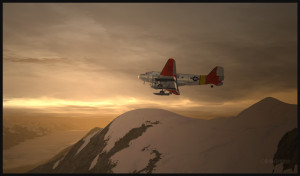It used to be called OpusFSX, but that was before P3D arrived on the market. Now it is OpusFSI (a more generic name applicable to many platforms)
OpusFSI
OpusFSI is a weather engine which, like FSGRW, ASN or REX, downloads real live weather close to your route and integrates it in your computer so that your virtual flight is always done in actualized weather. All those programs will update the data more frequently if the weather deteriorates along your flight path.
OpusFSI does not add new cloud texture sets. If you wish to fly in more interesting clouds, you need to use OpusFSI in combination with REX.
Opus works well on a network, which is practical if you want to transfer some OpusFSI functions towards a second computer to limit the use of the main computer’s resources.
OpusFSI is compatible with FSX, FSX: SE and P3D and even with TrackIR real-time 3D view controls (some files will have to be deactivated in the Program Files if you were using TrackIR before buying Opus). You have access to multiple interactive maps to check the weather or SIDs/Stars and to adjust the many options according to your taste.
OpusFSI is quite an advanced program that is well adapted to the use of virtual cockpit cameras. It replicates head movements caused by vibrations or turbulence and allows views from left to right when taxiing or turning in flight. The effects are all adjustable by the user.
If you are using many computer screens for your virtual flight, you can program each screen to show a different view (like the left and right window, for example).
OpusFSI allows you to use historical weather. The program also offers the possibility to relocate the weather over an airport towards another one. As well, you can decide to make some low clouds disappear or eliminate any obstruction to visibility when you want to have a perfect view of the territory. You can even create your own Metar.
Like for other weather engines on the market, you have access to a “flight planning mode”.
An option allows you to include turbulence and wind shear caused by the surrounding terrain within 80 kilometers of an airport.
The data generated by OpusFSI can be used directly in the PMDG B737NGX. That means you can see the real weather on the aircraft’s radar.
OpusFSI is in continual development and new functions are frequently added. They are not all mentioned in the present article.
Like for other weather engines available on the market, it is necessary for you to visit the company’s web site in order to choose the most appropriate software that will be adapted to your type of virtual flying and to the equipment that you use or intend to use in the future.
Here is the link: OpusFSI
For more weather engines, click on the following link: Other weather engines
For more articles on flight simulation on my web site, click on the following link : Flight simulation
